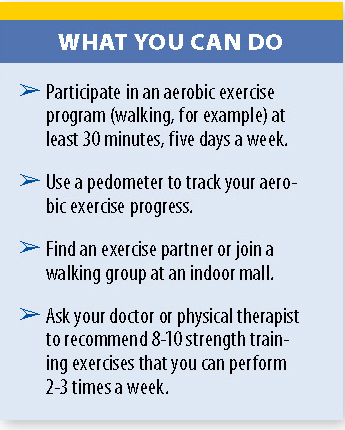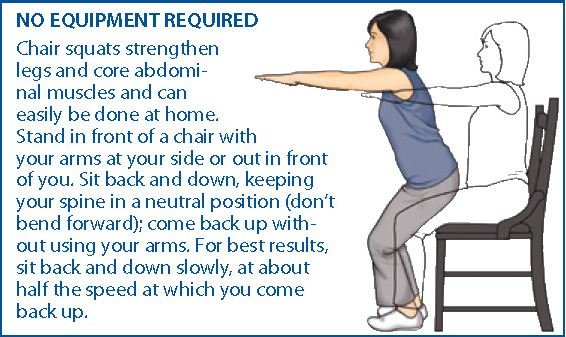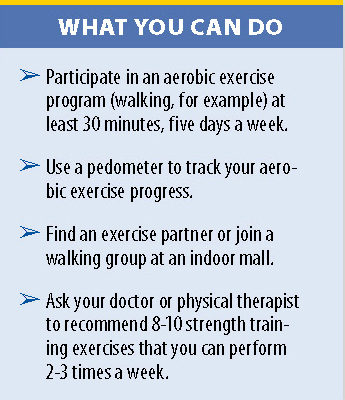Regular Exercise is Good for More Than Just your Waistline
We tend to think of exercise’s main benefits as keeping our weight down and maintaining good cardiovascular health. But we can add six more reasons why older adults should exercise regularly: 1) better overall health, 2) improved attention and 3) conflict resolution skills, 4) reduced risk of cognitive impairment, 5) stronger bones, and 6) less risk of falling.
 Catherine Sarkisian, MD, a geriatrician at UCLA Health System, says that many older adults simply don’t see exercise as an expected and important part of their lives anymore. “One common misperception is that being sedentary is part of normal aging,” she says. “While there are conditions that make being active impossible for a small number of older adults, the vast majority—even those with physical health conditions—should consider physical activity a vital part of normal aging.”
Catherine Sarkisian, MD, a geriatrician at UCLA Health System, says that many older adults simply don’t see exercise as an expected and important part of their lives anymore. “One common misperception is that being sedentary is part of normal aging,” she says. “While there are conditions that make being active impossible for a small number of older adults, the vast majority—even those with physical health conditions—should consider physical activity a vital part of normal aging.”
What kind, how often, how much
Both aerobic exercise and strength training have been shown to be important predictors of health. Aerobic exercise increases the heart rate to a higher, but safer level. Resistance training—working with light weights or against light resistance—challenges each muscle group and gradually increases muscle strength and muscle endurance.
“All seniors should do (at least) moderately intense aerobic exercise 30 minutes per day five days a week or vigorously intense aerobic exercise 20 minutes a day three times a week,” says Dr. Sarkisian.
She also recommends 8-10 strength training exercises, 10-15 repetitions of each exercise, 2-3 times per week. Those at risk for falls—something a physician can easily determine—should do exercises specifically designed to improve balance (for example, standing on one leg at a time, close to something stable in case support is needed).
How to start
“The first step is to make a plan and commit to sticking with it,” she continues. “For aerobic activities, choose activities you enjoy. Seniors with heart conditions should discuss their plans with their physician prior to starting, but most can start moderate physical activity without having an extensive cardiac evaluation. There are online resources to help you get started, such as those on the American College of Sports Medicine Web site. (www.acsm.org).
Maintaining bone health
Exercise is essential for maintaining bone strength and preventing osteoporosis. Weight-bearing exercise is the most effective for maintaining strong bones.
Bone growth is stimulated in two ways. The first is the force of a muscle pulling on the bone; the second, ground reaction force. So resistance (strength) training two to three times a week is important for bone health. Resistance bands, free weights, machines, or body weight exercises (like modified push-ups) are all effective methods of keeping bones strong.”
Walking, jogging, dancing, hiking, tennis, volleyball, step aerobics, zumba, and skipping rope are some examples of activities that are good for your bones and your heart.
How much is enough? But be aware that more exercise is not always better. The perfect exercise dose varies with each individual’s health status, time constraints, and personal goals. The general guidelines are to accumulate 150 minutes of moderate intensity exercise per week or 75 minutes of vigorous exercise. Brisk walking would count as moderate intensity, while jogging or running would be considered vigorous intensity for most people.
“However, anything is better than nothing. Every little bit counts. Just start finding ways to fit activity into the day—park farther away from a building, walk around the house during television commercial breaks, and use stairs instead of elevators.
 Walking is a great starting exercise
Walking is a great starting exercise
There is no need for complicated training and you don’t need to join a gym. Many people are motivated by wearing a pedometer to monitor their progress.
When weather or other environmental problems make walking difficult, consider joining a walking group at an indoor mall.
Outdated stereotypes. “Stereotypes of passive seniors who are ‘too old’ to start a serious exercise program need to be thrown out,” concludes Dr. Sarkisian. “Millions of seniors have committed themselves to exercise programs because they want to enjoy the short- and long-term benefits of better health and less disability. It takes some work, but it’s worth it. I encourage every person to find a program that works for you and stick with it. You won’t regret it.”
The post Regular Exercise is Good for More Than Just your Waistline appeared first on University Health News.
Read Original Article: Regular Exercise is Good for More Than Just your Waistline »
Powered by WPeMatico


